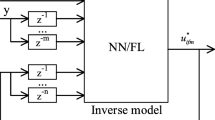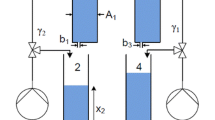Abstract
This paper initiatively proposes a novel inverse–adaptive multilayer T–S fuzzy controller (IFC + AF) optimized with differential evolution (DE) soft computing algorithm available for a class of robust control methods applied in uncertain nonlinear SISO and MISO systems. First, a novel multilayer T–S fuzzy model is created by combined multiple simple T–S fuzzy models with a sum function in the output. Then, the parameters of multilayer T–S fuzzy model are optimally identified using DE algorithm to create offline the inverse nonlinear system regarding uncertain system parameters. Second, an adaptive fuzzy-based sliding-mode surface is innovatively designed to guarantee that the closed-loop system is asymptotically stable using Lyapunov stability principle. Moreover, necessary benchmark tests are investigated in MATLAB/Simulink platform, including the spring–mass–damper SMD system and the fluid level of a double tank with uncertain parameters, in order to illustrate the effectiveness and the feasibility of the proposed IFC + AF control scheme. The IFC + AF control algorithm is adequately investigated with various control coefficients and is strictly compared with the advanced adaptive fuzzy control and the inverse fuzzy control (IFC) approaches. Simulation and experiment results are satisfactorily investigated and demonstrate the feasibility and performance of the proposed IFC + AF control method.


















Similar content being viewed by others
References
Anh HPH et al (2018) Parameter identification using adaptive differential evolution algorithm applied to robust control of uncertain nonlinear systems. Appl Soft Comput 71:672–684
Berrazouane et al (2014) Parameter optimization via cuckoo optimization algorithm of fuzzy controller for energy management of a hybrid power system. Energy Convers Manag 78:652–660
Chen C-H, Liu C-B (2017) Reinforcement learning-based differential evolution with cooperative coevolution for a compensatory neuro-fuzzy controller. IEEE Trans Neural Netw Learn Syst 29:4719–4729
De Silva CW (2018) Intelligent control: fuzzy logic applications. CRC Press, Boca Raton
Deng W et al (2017a) A novel collaborative optimization algorithm in solving complex optimization problems. Soft Comput 21(15):4387–4398
Deng W et al (2017b) Study on an improved adaptive PSO algorithm for solving multi-objective gate assignment. Appl Soft Comput 59:288–302
Deng W, Xu J, Zhao H (2019) An improved ant colony optimization algorithm based on hybrid strategies for scheduling problem. IEEE Access 7:20281–20292
Ebtehaj I, Bonakdari H (2017) Design of a fuzzy differential evolution algorithm to predict non-deposition sediment transport. Appl Water Sci 7:4287–4299
Huan TT et al (2018) Adaptive gait generation for humanoid robot using evolutionary neural model optimized with modified differential evolution technique. Neurocomputing 320:112–120
Kumbasar T et al (2012) Type-2 fuzzy model based controller design for neutralization processes. ISA Trans 51(2):277–287
Kumbasar T et al (2017) An inverse controller design method for interval type-2 fuzzy models. Soft Comput 21(10):2665–2686
Li H et al (2015) Control of nonlinear networked systems with packet dropouts: interval type-2 fuzzy model-based approach. IEEE Trans Cybern 45(11):2378–2389
Li H et al (2017a) Adaptive sliding mode control for Takagi-Sugeno fuzzy systems and its applications. IEEE Trans Fuzzy Syst 26:531–542
Li J et al (2017b) Robust stabilization of TS fuzzy stochastic descriptor systems via integral sliding modes. IEEE Trans Cybern 48:2736–2749
Li Y et al (2017c) Adaptive fuzzy output-feedback stabilization control for a class of switched nonstrict-feedback nonlinear systems. IEEE Trans Cybern 47(4):1007–1016
Li Y, Sui S, Tong S (2017d) Adaptive fuzzy control design for stochastic nonlinear switched systems with arbitrary switchings and unmodeled dynamics. IEEE Trans Cybern 47(2):403–414
Li H et al (2017e) Adaptive fuzzy back-stepping tracking control for strict-feedback systems with input delay. IEEE Trans Fuzzy Syst 25(3):642–652
Li J et al (2018) Observer-based fuzzy integral sliding mode control for nonlinear descriptor systems. IEEE Trans Fuzzy Syst 26:2818–2832
Liu H et al (2017) Adaptive fuzzy back-stepping control of fractional-order nonlinear systems. IEEE Transactions on Systems, Man, and Cybernetics: Systems 47(8):2209–2217
Liu Y-J et al (2018) Adaptive fuzzy output feedback control for a class of nonlinear systems with full state constraints. IEEE Trans Fuzzy Syst 26:2607–2617
Mendel JM (2014) General type-2 fuzzy logic systems made simple: a tutorial. IEEE Trans Fuzzy Syst 22(5):1162–1182
Mendel JM, John RIB (2002) Type-2 fuzzy sets made simple. IEEE Trans Fuzzy Syst 10(2):117–127
Mi Y et al (2018) Intelligent power sharing of DC isolated microgrid based on fuzzy sliding mode droop control. IEEE Trans Smart Grid 10:2396–2406
Nasiri A et al (2017) Reducing conservatism in H-infinity robust state feedback control design of TS fuzzy systems: a non-monotonic approach. IEEE Trans Fuzzy Syst 26(1):386–390
Precup R-E, Hellendoorn H (2011) A survey on industrial applications of fuzzy control. Comput Ind 62(3):213–226
Qiu J et al (2016) Recent advances on fuzzy-model-based nonlinear networked control systems: a survey. IEEE Trans Ind Electron 63(2):1207–1217
Raju GVS, Zhou J, Kisner RA (1991) Hierarchical fuzzy control. Int J. Control 54(5):1201–1216
Sadek U et al (2017) Improved adaptive fuzzy back-stepping control of a magnetic levitation system based on symbiotic organism search. Appl Soft Comput 56:19–33
Salehpour M et al (2017) A new adaptive differential evolution optimization algorithm based on fuzzy inference system. Eng Sci Technol Int J 20(2):587–597
Salhi I et al (2017) Takagi-Sugeno fuzzy modeling for three-phase micro hydropower plant prototype. Int J Hydrogen Energy 42(28):17782–17792
Son NN et al (2020) Parameters identification of Bouc–Wen hysteresis model for piezoelectric actuators using hybrid adaptive differential evolution and Jaya algorithm. Eng Appl Artif Intell 87:103317
Soufi Y et al (2017) Fuzzy-PSO controller design for maximum power point tracking in photovoltaic system. Int J Hydrogen Energy 42(13):8680–8688
Sundarabalan CK, Selvi K (2017) Real coded GA optimized fuzzy logic controlled PEMFC based Dynamic Voltage Restorer for reparation of voltage disturbances in distribution system. Int J Hydrogen Energy 42(1):603–613
Torra V (2002) A review of the construction of hierarchical fuzzy systems. Int J Intell Syst 17(5):531–543
Tu K-Y, Lee T-T, Wang W-J (2000) Design of a multilayer fuzzy logic controller for multi-input multi-output systems. Fuzzy Sets Syst 111(2):199–214
Van Kien C, Son NN, Anh HPH (2017) Identification of 2-DOF pneumatic artificial muscle system with multilayer fuzzy logic and differential evolution algorithm. In: The 12th IEEE conference on industrial electronics and applications (ICIEA 2017), pp 1261–1266
Wang D, Mu C (2017) Adaptive-critic-based robust trajectory tracking of uncertain dynamics and its application to a spring mass-damper system. IEEE Trans Ind Electron 99(99):1–10
Wang Y et al (2017) Dissipativity-based fuzzy integral sliding mode control of continuous-time TS fuzzy systems. IEEE Trans Fuzzy Syst 26:1164–1176
Wei Y et al (2017) A new design of H-infinity piecewise filtering for discrete-time nonlinear time-varying delay systems via T–S fuzzy affine models. IEEE Trans Syst Man Cybern Syst 47(8):2034–2047
Wen S et al (2017) Fuzzy control for uncertain vehicle active suspension systems via dynamic sliding-mode approach. IEEE Trans Syst Man Cybern Syst 47(1):24–32
Xue Y, Zheng B-C, Yu X (2017) Robust sliding mode control for TS fuzzy systems via quantized state feedback. IEEE Trans Fuzzy Syst 26:2261–2272
Zadeh LA (1965) Fuzzy sets. Inf Control 8(8):338–3365
Zhao H, Zheng J, Xu J, Deng W (2019a) Fault diagnosis method based on principal component analysis and broad learning system. IEEE Access 7:99263–99272
Zhao H, Liu H, Xu J, Deng W (2019b) Performance prediction using high-order differential mathematical morphology gradient spectrum entropy and extreme learning machine. In: IEEE Transactions on instrumentation and measurement
Zhou Q et al (2017) Adaptive fuzzy control for non-strict-feedback systems with input saturation and output constraint. IEEE Trans Syst Man Cybern Syst 47(1):1–12
Zou W, Li C, Zhang N (2017) A TS fuzzy model identification approach based on a modified inter type-2 FRCM algorithm. IEEE Trans Fuzzy Syst 26:1104–1113
Acknowledgements
This paper is funded by Industrial University of Ho Chi Minh City (IUH) under Grant Number 19.3ĐT01.
Author information
Authors and Affiliations
Corresponding author
Ethics declarations
Conflict of interest
There is no conflict of interest from authors related to this manuscript.
Additional information
Communicated by V. Loia.
Publisher's Note
Springer Nature remains neutral with regard to jurisdictional claims in published maps and institutional affiliations.
Rights and permissions
About this article
Cite this article
Van Kien, C., Anh, H.P.H. & Son, N.N. Inverse–adaptive multilayer T–S fuzzy controller for uncertain nonlinear system optimized by differential evolution algorithm. Soft Comput 24, 14073–14089 (2020). https://doi.org/10.1007/s00500-020-04782-2
Published:
Issue Date:
DOI: https://doi.org/10.1007/s00500-020-04782-2




